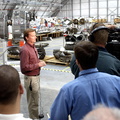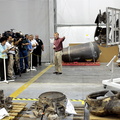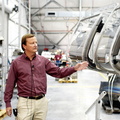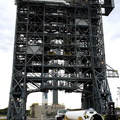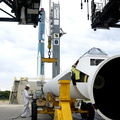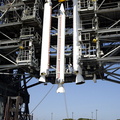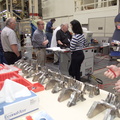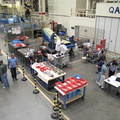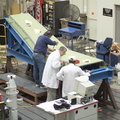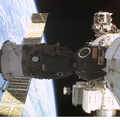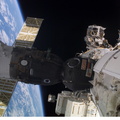
WIKIARCHIVES.SPACE
The Human Spaceflight Archive

Information
- Taken in
- Kennedy Space Center
- Author
- NASA
- Description
- While one solid rocket booster (SRB) is suspended in the launch tower on Launch Complex 17-A, Cape Canaveral Air Force Station, another is raised from its transporter for a similar lift. They are two of nine SRBs that will be mated to the Delta rocket to launch Mars Exploration Rover 2. NASAs twin Mars Exploration Rovers are designed to study the history of water on Mars. These robotic geologists are equipped with a robotic arm, a drilling tool, three spectrometers, and four pairs of cameras that allow them to have a human-like, 3D view of the terrain. Each rover could travel as far as 100 meters in one day to act as Mars scientists' eyes and hands, exploring an environment where humans cant yet go. MER-2 is scheduled to launch June 5 as MER-A. MER-1 (MER-B) will launch June 25.
- Created on
- Wednesday 14 May 2003
- Albums
-
Locations / OSM-4.915832801313164
US SPACE PROGRAM / PROBES / MARS / MARS EXPLORATION ROVERS / SPIRIT / Rocket preparation
- Source link
- https://science.ksc.nasa.gov/gallery/photos/2003/
- Visits
- 19
- Rating score
- no rate
- Rate this photo
- License
- CC BY-NC-ND
- Modified by WikiArchives
- No (original)
- Downloads
- 0
Powered by Piwigo
